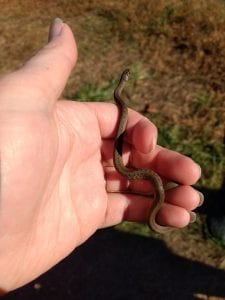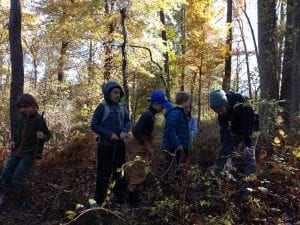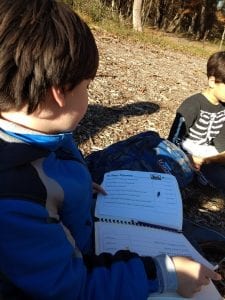10/30/2018
Today we re-explored some of our favorite places at Irvine, the seven sycamore tree along the Bauer Path trail and the Native American site. We set off from our meeting spot, along the Vista Loop Trail and stopped at the Gazebo and enjoyed snack and sharing moments from over the weekend or since last class. Since our class fell on Halloween we also shared our Halloween costume and any Halloween stories we had! We hiked through the meadow but we didn’t get very far because Julien found a tiny brown snake! It stopped on the path and we were able to pick it up. It didn’t move much in our hands and didn’t seem upset about being handled but we didn’t want to handle it too long and cause it much stress. We observed its markings and noted that it didn’t have any patterns on its back nor did it have any stripes. It didn’t look like a baby garter snake, so what was it? We weren’t sure so we took a photo and later identified it as a Dekay’s Brown Snake (pictured below, snake pictured in hand). Apparently they stay quite small so this one could have been an adult! They stay so small that they don’t eat things much larger than an insect or slug!
We gently let the snake slither back into the tall grasses of the meadow and continued down the trail. After a brief stop at the bridge, exploring the stream, we found ourselves at the large seven sycamore tree. This tree provides a safe spot for our homeschool kids to climb and explore. Climbing provides children with very important muscle development that they just don’t get doing everyday activities. It also helps grow confidence and encourages them to make a judgement call as to whether they feel they can safely climb to a certain height (which we set for safety reasons). Here we split into two groups. One group stayed and enjoyed climbing and fort building while the other group spent time at the Native American site close by (the groups switched after about 15 minutes).
At the Native American site we met in the longhouse and briefly went over what we were going to do here. Since the Native American site is one of our favorite places to be we also need to remember to be good stewards of the places we visit. Being a steward means offering your time to help make a place even better than how you found it. Each group spent about 5 minutes fixing the fire ring, righting tipped logs, removing extra logs and limbs from inside the longhouse and tidying up. After some stewardship we played a Native American game. Here is a link to some traditional games:
This game was played by Native American children, including the Lenape. We thought about what it would have been like to live during the time of the Lenape people. Our lives would have been a lot different, even for children. Children were expected to help out around the village by gathering materials and nuts and berries. They were also asked to help out with village and family chores and practice hunting at a young age (especially the boys). This game helped young Lenape hone their precision (getting the object through the hoop successfully over and over) and accuracy (just being able to make it through the hoop), which helped their hunting skills as young adults. This game was played with sticks, corn cobs, soft hide sacks and so forth but we used first sized pieces of wood.
After some play we gathered together in the longhouse and read the story “How Turtle Flew South for the Winter” from the Keepers of the Earth book by Michael J. Caduto and Joseph Bruchac. This story tells the tale of how turtle wanted to fly south for the winter but lacked the ability to fly, like the birds. He asked the birds to help carry him south. They agreed but said he had to hold onto a stick with his mouth as they carried him but he wouldn’t be able to talk. Turtle was impatient and wanted to speak to the birds. After a time he couldn’t wait any longer and opened his mouth to speak but in doing so fell to the earth. After he hit the ground his shell cracked and he burrowed under the mud to wait until spring. This Sioux Native American tale explains why turtle has a cracked shell and hibernates in the winter.
On our way back to Irvine Julien found a second snake, this one a garter snake (see the pictures below). A future herpetologist!









